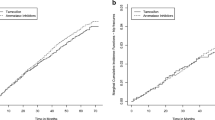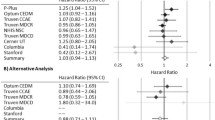Abstract
Clinical trials suggest that increased risk of osteoporosis and fracture are the only serious side effects of adjuvant aromatase inhibitors (AIs), but little is known regarding toxicities of AIs in non-trial populations. We evaluated whether use of AIs was associated with myocardial infarction, stroke, and fracture in a community-based population. Using data from the HealthCore Integrated Research Database, 44,463 women aged ≥50 years with ≥2 breast cancer diagnosis codes between 2001 and 2007 were followed through 2008. Of these, 44,026 were matched using propensity score methods to women aged ≥50 years with no breast cancer codes. We assessed whether treatment with AIs was associated with myocardial infarction, stroke, and fracture using Cox proportional hazards models with time-varying treatment variables. Among breast cancer patients, 68.7% received no hormonal therapy, 20.6% received AIs (15.8% received only AIs, 4.8% were also treated with tamoxifen), and 10.7% received tamoxifen only. Breast cancer patients on AIs had a higher risk of any fracture (AHR = 1.13, 95% CI = 1.02–1.25) than breast cancer patients not receiving hormonal therapy. Patients on tamoxifen had a lower risk of hip fracture (AHR = 0.51, 95% CI = 0.32–0.81) than breast cancer patients not receiving hormonal therapy. Rates of myocardial infarction and stroke for patients on AIs or tamoxifen did not differ significantly from breast cancer patients not on therapy. The side effect profile of AIs in this community-based population was similar to that seen in clinical trials. These findings provide reassurance that AIs appear to be associated with few serious side effects.

Similar content being viewed by others
References
American Cancer Society (2010) Cancer facts & figures 2010. American Cancer Society, Atlanta
Burstein HJ, Prestrud AA, Seidenfeld J, Anderson H, Buchholz TA, Davidson NE, Gelmon KE, Giordano SH, Hudis CA, Malin J, Mamounas EP, Rowden D, Solky AJ, Sowers MR, Stearns V, Winer EP, Somerfield MR, Griggs JJ (2010) American Society of Clinical Oncology clinical practice guideline: update on adjuvant endocrine therapy for women with hormone receptor-positive breast cancer. J Clin Oncol 28:3784–3796
Goss P, Ingle J, Martino S, Robert N, Muss H (2003) A randomized trial of letrozole in postmenopausal women after five years of tamoxifen therapy for early-stage breast cancer. N Engl J Med 349:1793–1802
Jakesz R, Jonat W, Gnant M, Mittlboeck M (2005) Switching of postmenopausal women with endocrine-responsive early breast cancer to anastrozole after 2 years adjuvant tamoxifen: combined results from ABCSG Trial 8 and the ARNO 95 Trial. Lancet 366:455–462
Coombes RC, Kilburn LS, Snowdon CF, Paridaens R, Coleman RE, Jones SE, Jassem J, Van de Velde CJ, Delozier T, Alvarez I, Del Mastro L, Ortmann O, Diedrich K, Coates AS, Bajetta E, Holmberg SB, Dodwell D, Mickiewicz E, Andersen J, Lonning PE, Cocconi G, Forbes J, Castiglione M, Stuart N, Stewart A, Fallowfield LJ, Bertelli G, Hall E, Bogle RG, Carpentieri M, Colajori E, Subar M, Ireland E, Bliss JM (2007) Survival and safety of exemestane versus tamoxifen after 2–3 years’ tamoxifen treatment (Intergroup Exemestane Study): a randomized controlled trial. Lancet 369:559–570
Colleoni M, Giobbie-Hurder A, Regan MM, Thurlimann B, Mouridsen H, Mauriac L, Forbes JF, Paridaens R, Lang I, Smith I, Chirgwin J, Pienkowski T, Wardley A, Price KN, Gelber RD, Coates AS, Goldhirsch A (2011) Analyses adjusting for selective crossover show improved overall survival with adjuvant letrozole compared with tamoxifen in the BIG 1–98 Study. J Clin Oncol 29:1117–1124
Forbes JF, Cuzick J, Buzdar A, Howell A, Tobias JS, Baum M (2008) Effect of anastrozole and tamoxifen as adjuvant treatment for early-stage breast cancer: 100-month analysis of the ATAC trial. Lancet Oncol 9:45–53
Ries L, Eisner M, Kosary C (2003) SEER cancer statistics review, 1975–2000. National Cancer Institute, Bethesda, MD
Center for Disease Control and Prevention, Department of Vital Statistics. http://www.cdc.gov/nchs/nvss/mortality/lcwk10.htm
Arimidex, Tamoxifen, Alone or in Combination Trialists’ Group (2005) Results of the ATAC (arimidex, tamoxifen, alone or in combination) trial after completion of 5 years’ adjuvant treatment for breast cancer. Lancet 365:60–62
Thurlmann B, Keshaviah A, Mouridsen H, Mauriac L (2005) BIG 1–98: randomized double-blind phase III study to evaluate letrozole (L) vs. tamoxifen (T) as adjuvant endocrine therapy for postmenopausal women with receptor-positive breast cancer. J Clin Oncol 23:511
Coombes R, Hall M, Gibson L, Paridaens R (2004) A randomized trial of exemestane after two to three years of tamoxifen therapy in postmenopausal women with primary breast cancer. N Engl J Med 350:1081–1092
Amir E, Ocana A, Niraula S, Carlsson L, Scruga B (2010) Toxicity of adjuvant endocrine therapy in postmenopausal breast cancer patients. In: San Antonio Breast Cancer symposium, Edition San Antonio, TX
Cuppone F, Bria E, Verma S, Pritchard KI, Gandhi S, Carlini P, Milella M, Nistico C, Terzoli E, Cognetti F, Giannarelli D (2008) Do adjuvant aromatase inhibitors increase the cardiovascular risk in postmenopausal women with early breast cancer? Meta-analysis of randomized trials. Cancer 112:260–267
Keating NL, O’Malley AJ, Smith MR (2006) Diabetes and cardiovascular disease during androgen deprivation therapy for prostate cancer. J Clin Oncol 24:4448–4456
Marciniak TA, Ellerbeck EF, Radford MJ, Kresowik TF, Gold JA, Krumholz HM, Kiefe CI, Allman RM, Vogel RA, Jencks SF (1998) Improving the quality of care for Medicare patients with acute myocardial infarction: results from the Cooperative Cardiovascular Project. JAMA 279:1351–1357
Klabunde CN, Potosky AL, Legler JM, Warren JL (2000) Development of a comorbidity index using physician claims data. J Clin Epidemiol 53:1258–1267
Charlson ME, Pompei P, Ales KL, MacKenzie CR (1987) A new method of classifying prognostic comorbidity in longitudinal studies: development and validation. J Chronic Dis 40:373–383
Schneeweiss S, Seeger JD, Maclure M, Wang PS, Avorn J, Glynn RJ (2001) Performance of comorbidity scores to control for confounding in epidemiologic studies using claims data. Am J Epidemiol 154:854–864
Farley JF, Harley CR, Devine JW (2006) A comparison of comorbidity measurements to predict healthcare expenditures. Am J Manag Care 12:110–119
Rosenbaum PR, Rubin DB (1984) Difficulties with regression analyses of age-adjusted rates. Biometrics 40:437–443
D’Agostino RB Jr (1998) Propensity score methods for bias reduction in the comparison of a treatment to a non-randomized control group. Stat Med 17:2265–2281
Partridge AH, LaFountain A, Mayer E, Taylor BS, Winer E, Asnis-Alibozek A (2008) Adherence to initial adjuvant anastrozole therapy among women with early-stage breast cancer. J Clin Oncol 26:556–562
Coronary Drug Project Research Group (1980) Influence of adherence to treatment and response of cholesterol on mortality in the Coronary Drug Project Group. N Engl J Med 303:1038–1041
Curtis J, Larson JC, Delzell E, Brookhart MA, Cadarette SM, Chlebowski R, Judd S, Safford M, Solomon DH, Lacroix AZ (2011) Placebo adherence, clinical outcomes, and mortality in the women’s health initiative randomized hormone therapy trials. Med Care 49:427–435
Joensuu H, Holli K, Oksanen H, Valavaara R (2000) Serum lipid levels during and after adjuvant toremifene or tamoxifen therapy for breast cancer. Breast Cancer Res Treat 63:225–234
Keating NL, Landrum MB, Brooks JM, Chrischilles EA, Winer EP, Wright K, Volya R (2011) Outcomes following local therapy for early-stage breast cancer in non-trial populations. Breast Cancer Res Treat 125:803–813
Hassett MJ, O’Malley AJ, Keating NL (2009) Factors influencing changes in employment among women with newly diagnosed breast cancer. Cancer 115:2775–2782
Hershman D, McBride R, Jacobson JS, Lamerato L, Roberts K, Grann VR, Neugut AI (2005) Racial disparities in treatment and survival among women with early-stage breast cancer. J Clin Oncol 23:6639–6646
Acknowledgments
This study was funded by the National Institutes of Health (R01 CA127652 to Dr. Keating).
Disclosures
Dr. Eric Winer received an honorarium from Novartis for consulting work. The other authors have no disclosures.
Author information
Authors and Affiliations
Corresponding author
Appendix
Appendix
See Table 5.
Rights and permissions
About this article
Cite this article
Ligibel, J.A., James O’Malley, A., Fisher, M. et al. Risk of myocardial infarction, stroke, and fracture in a cohort of community-based breast cancer patients. Breast Cancer Res Treat 131, 589–597 (2012). https://doi.org/10.1007/s10549-011-1754-1
Received:
Accepted:
Published:
Issue Date:
DOI: https://doi.org/10.1007/s10549-011-1754-1




